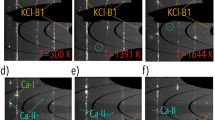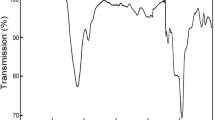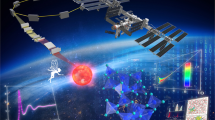Abstract
THERE is evidence for reaction between mixtures of pure anhydrous LiCl and CrCl3 when they are fused at between 500° and 700° C, and the resultant melts are cooled. An equation can be written  This evidence consisted of the destruction of the characteristic purple, insoluble layer crystals of CrCl3 and the formation of a pink salt soluble in water. Reaction 1 is written in analogy to the reactions believed to occur in the NaCl–CrCl3 and the KCl–CrCl3 systems with fusion and cooling. Cook1 has reported the formation of Na3CrCl6 and K3CrCl6 in these systems. Such reactions can be regarded as depolymerizing reactions without change in either the covalence or oxidation state of the central metal atoms.
This evidence consisted of the destruction of the characteristic purple, insoluble layer crystals of CrCl3 and the formation of a pink salt soluble in water. Reaction 1 is written in analogy to the reactions believed to occur in the NaCl–CrCl3 and the KCl–CrCl3 systems with fusion and cooling. Cook1 has reported the formation of Na3CrCl6 and K3CrCl6 in these systems. Such reactions can be regarded as depolymerizing reactions without change in either the covalence or oxidation state of the central metal atoms.
This is a preview of subscription content, access via your institution
Access options
Subscribe to this journal
Receive 51 print issues and online access
$199.00 per year
only $3.90 per issue
Buy this article
- Purchase on Springer Link
- Instant access to full article PDF
Prices may be subject to local taxes which are calculated during checkout
Similar content being viewed by others
References
Cook, C. N., J. Inorg. Nucl. Chem., 25, 123 (1962).
Hahn, E. L., Phys. Rev., 77, 297 (1950).
Gardner, J. J., and Janz, G. J., J. Chem. Phys., 60, 1458 (1958).
Maricle, D. L., and Hume, D. N., J. Electrochem. Soc., 107, 354, 356 (1960).
Author information
Authors and Affiliations
Rights and permissions
About this article
Cite this article
MCGAVOCK, W., HARLOWE, W. Nuclear Magnetic Resonance in Phase Stud: LiCl–CrCl3. Nature 220, 1230–1231 (1968). https://doi.org/10.1038/2201230b0
Received:
Issue Date:
DOI: https://doi.org/10.1038/2201230b0
Comments
By submitting a comment you agree to abide by our Terms and Community Guidelines. If you find something abusive or that does not comply with our terms or guidelines please flag it as inappropriate.



